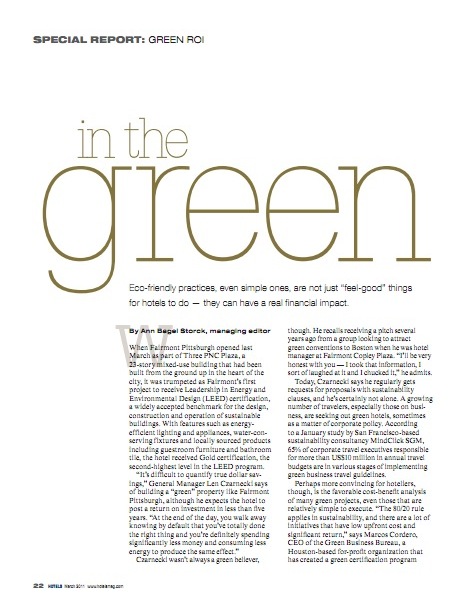HOTELS - In the Green interview with Yvette Jong
Yvette Jong, Founder and Director of Craft House, was interviewed by HOTELS Magazine, the magazine of the worldwide hotel industry, on the topic of sustainable practices in hotels across the world.
By Ann Bagel Storck, Managing Editor
When Fairmont Pittsburgh opened last March as part of Three PNC Plaza, a 23-story mixed-use building that had been built from the ground up in the heart of the city, it was trumpeted as Fairmont’s first project to receive Leadership in Energy and Environmental Design (LEED) certification, a widely accepted benchmark for the design, construction and operation of sustainable buildings. With features such as energy efficient lighting and appliances, water-conserving fixtures and locally sourced products including guestroom furniture and bathroom tile, the hotel received Gold certification, the second-highest level in the LEED program.
“It’s difficult to quantify true dollar savings,” General Manager Len Czarnecki says of building a “green property like Fairmont Pittsburgh, although he expects the hotel to post a return on investment in less than five years. “At the end of the day, you walk away knowing by default that you’ve totally done the right thing and you’re definitely spending significantly less money and consuming less energy to produce the same effect.”
Czarnecki wasn’t always a green believer, though. He recalls receiving a pitch several years ago from a group looking to attract green conventions to Boston when he was hotel manager at Fairmont Copley Plaza. “I’ll be very honest with you — I took that information, I sort of laughed at it and I chucked it,” he admits.
Today, Czarnecki says he regularly gets requests for proposals with sustainability clauses, and he’s certainly not alone. A growing number of travelers, especially those on business, are seeking out green hotels, sometimes as a matter of corporate policy. According to a January study by San Francisco-based sustainability consultancy MindClick SGM, 65% of corporate travel executives responsible for more than US$10 million in annual travel budgets are in various stages of implementing green business travel guidelines.
Perhaps more convincing for hoteliers, though, is the favorable cost-benefit analysis of many green projects, even those that are relatively simple to execute. “The 80/20 rule applies in sustainability, and there are a lot of initiatives that have low upfront cost and significant return,” says Marcos Cordero, CEO of the Green Business Bureau, a Houston-based for-profit organization that has created a green certification program specifically for hotels. “In the case of energy and waste reduction, these initiatives are the gifts that keep on giving. As energy costs continue to increase at a rate greater than inflation, hotels that aren’t optimizing their energy and waste will become increasingly less competitive.
MVPs: Most valuable projects
There are a lot of low-hanging fruit for hotels to pick when it comes to starting down a path toward sustainable operations. Bob Holesko, vice president of facilities for HEI Hotels & Resorts, a Norwalk, Connecticut-based hospitality investment firm that was honored as an Energy Star Partner of the Year last year by the U.S. Environmental Protection Agency and the U.S. Department of Energy, identifies lighting retrofits among the simplest green initiatives for any hotel, yielding payback in less than a year.
“You’re going to take a 100-watt incandescent and replace it with a 20-watt compact fluorescent,” Holesko says. “You’re going to get the same light output, and you just saved 80%. It’s a slam dunk. To this day we buy hotels that still haven’t done that, and we just go, ‘Cha-ching.” We can make this hotel better.”
Energy management — often as straightforward as installing programmable thermostats in guestrooms — is another critical element of a sustainable hotel. Of HEI’s more than 10,000 guestrooms, 90% have programmable thermostats, according to Holesko, which have a ROI from about two to four years depending on gas and electric rates in a given region.
Waste management also is key. Czarnecki highlights an enzyme-based digester at Fairmont Pittsburgh that composts food scraps and sends the byproduct into the wastewater stream, essentially eliminating up to 20 tons of food waste monthly. Although the system cost US$23,700, Czarnecki says it was worth it not only because of cost savings from fewer truck runs to pick up the garbage, but also because the digester obviates the need for a smelly dumpster that could attract pests. “It’s not inexpensive,” he concedes, “but when you get into larger hotels this really makes sense.”
Marriott International has more than 20 years of energy conservation experience, and recently has found impressive savings in LEED-certified buildings. The first LEED-designed Courtyard by Marriott, which debuted last September in suburban Pittsburgh as a project created by Concord Hospitality Enterprises with support from Marriott, is expected to reduce energy usage by an average of 24% annually, producing annual operating savings of US$50,000. It will be the prototype for all forthcoming LEED compliant Courtyards, saving future design and certification costs. Marriott is aiming to have 300 LEED-certified hotels by 2015.
There is one important piece of sustainable strategies that many hotels overlook: the human factor. “To really be successful in this, it’s not just that you have the right hardware. It’s not just that you have the right waste hauling contract,” notes Zachary Conen, vice president of sales and marketing, U.S. region, for Green Key Global, which recognizes sustainable hotels through its Eco-Rating Program. “It’s that the people you have working at the hotel are very engaged in the process — not only to execute the standards that are in place, but also to look for opportunities on their own.”
ROI ranges The speed with which green initiatives yield ROI varies, of course, although in general ROI goals mirror standards that hotel companies use for any capital investment, according to Patrick Maher, partner at the Maher Group, an Annapolis, Maryland-based sustainability consultancy serving hospitality and retail clients. “In most cases, if the ROI on the green investment is three years or less, it gets the necessary funding,” Maher notes.
ROI in three years or less is the goal Holesko has for his green projects, but he adds that in order to get initiatives with longer payback times approved, he combines them with projects like lighting that promise quick ROI.
Maher cautions that sometimes hotels make the mistake of not having a measurement system in place to benchmark their results, which make ROI calculations difficult, if not impossible. However, ROI is not always the main motivator behind green initiatives. “Some hotels are located in countries that subsidize water or energy, and will never realize financial benefits from green hardware. Others find that the ROI is slightly less than what they had hoped for,” explains Yvette Jong, senior consultant at Horwath HTL and primary author of a report about the business case for sustainable hotels in Asia. “Despite this, some hoteliers still choose to [implement green projects] as a measure to be environmentally responsible.”
Divi Resorts, which has nine resorts on six Caribbean islands, has followed various earth-friendly practices for years, says Divi Hotels Marketing Inc. CEO E.J. Schanfarber, but only recently began considering ROI on such initiatives. “We feel because in many cases we’re one of the largest operators on the islands, it’s a core responsibility of ours to ensure that the islands remain clean and that there’s no unnecessary depletion of natural resources,” Schanfarber explains.
Now, however, Divi is in the late stages of installing wind turbines — at a cost of US$250,000 apiece — to generate power in Aruba and St. Maarten. “Obviously when you get into that type of an investment ROI has to be a factor,” Schanfarber says. “For bigger projects like turbines, if we can see ROI within five years that’s an acceptable return.”
Like Divi’s properties, Wolgan Valley Resort & Spa, which opened in October 2009 on Australia’s Great Dividing Range, is located in an area of pristine beauty, and was conceived as a luxury conservation-based resort. The US$125.7 million project supports wide-ranging conservation practices focusing on endangered species protection — the resort is committed to planting native trees indigenous to the area, for example — in addition to featuring a plethora of sustainable design elements to save energy and water. The environment was even a factor while the resort was being built — during the construction phase, all contractors on site received extensive training on how to prevent environmental damage and protect local flora and fauna.
General Manager Joost Heymeijer notes that when a project includes conservation programs as Wolgan does, ROI objectives are long-range, exceeding 10 to 15 years. However, he adds, “There should not be a price tag associated with sustainability.”
Common sense
ROI becomes moot, however, if green initiatives are not palatable to guests. “We can help lead the guest in new directions, but we also have to be careful about not losing guests,” says Kathleen Matthews, Marriott’s executive vice president of global communications and public affairs.
Matthews notes, however, that guests’ willingness to adapt should not be overlooked. For example, Marriott subsidiary Ritz-Carlton long resisted a linen reuse program in its guestrooms for fear of upsetting its luxury guests, but piloted the program in the hopes of finding added efficiencies during the recession. “They had absolutely no pushback,” Matthews says.
There has been a lingering idea in some circles that going green cheapens a hotel’s image, but Green Key’s Conen thinks that belief is fading. “As the product offerings that cater to running a sustainable hotel have improved, I think the notion that green involves scratchy toilet paper and ugly blue recycling bins is outdated,” he says.
On the contrary, Czarnecki says that at Fairmont Pittsburgh, thanks to features like carpets with no or low emissions of volatile organic compounds, 100% indoor air from the outside and lots of natural light, guests can have a more pleasant stay at a green hotel than a conventional property.
Divi uses a somewhat obvious workaround when it comes to potential guest problems with green initiatives: If a guest dislikes the energy-efficient lighting in their room, for example, an engineer replaces it with an incandescent bulb for the duration of that guest’s stay. “In a case where we’re suggesting a practice that may affect guests’ stay,” Schanfarber explains, “we allow them to choose.”
It’s that kind of common-sense approach that is perhaps the most useful lesson for hotels as they consider their green options. “My takeaway in all this is do the right thing,” Czarnecki says. “Just deploy things that make sense. It’s not rocket science.”


